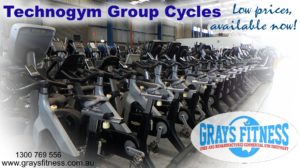Sustainability and Affordability: The Key Drivers behind the Refurbished Fitness Equipment Boom

Exploring Industry Potential, Growth Catalysts, Competition, Highlights, Market Dynamics, and Beyond
Welcome to the world of Refurbished Fitness Equipment, a rapidly growing market with a valuation of USD 1.43 Billion in 2022, and a promising trajectory to reach nearly USD 2.12 Billion by 2029, boasting a remarkable Compound Annual Growth Rate (CAGR) of 5.78% from 2023 to 2029. (Data as per Allied Market Research) Being spearheaded by industry frontrunners such as Grays Fitness, the largest refurbished gym equipment retailer in Australia and one of the top 5 players in the world, the potential within this sector holds remarkable promise.
But what exactly is refurbished fitness equipment? It’s more than just second-hand gym gear; it’s a rejuvenated version of used equipment restored to its original glory or close to brand-new condition. This entails a comprehensive process of cleaning, repairing, and replacing worn-out or damaged parts, ensuring both safety and functionality, while significantly prolonging its lifespan. From treadmills and ellipticals to exercise bikes and weight machines, refurbished fitness equipment offers a cost-effective alternative to purchasing brand-new gear, making it an ideal choice for those setting up a home gym or working within a tight budget. However, not all refurbished equipment is equal, and it’s crucial to source from reputable suppliers who have diligently inspected and refurbished the gear to ensure utmost safety and reliability for your fitness journey.
The COVID-19 pandemic has driven a significant surge in the demand for fitness equipment as individuals sought ways to stay active and maintain their health while adhering to social distancing measures and staying at home more frequently. The closure of gyms and fitness centres further fuelled the demand for home gym equipment. Moreover, the pandemic underscored the importance of leading a healthy lifestyle and bolstering one’s immunity to combat illnesses. Regular exercise and a balanced diet emerged as essential components of a healthy life, prompting many people to turn to fitness equipment for staying active and improving their overall well-being during the pandemic.
This increased demand for fitness equipment resulted in a notable boom in the fitness equipment industry, with many companies experiencing record-breaking sales in the past year. Notably, this trend is expected to persist even after the pandemic subsides, as people continue to prioritize their health and fitness. The lasting impact of the pandemic has reshaped the way individuals approach their fitness routines, with a continued emphasis on maintaining a healthy lifestyle and integrating fitness equipment into their daily lives. As a result, the fitness equipment industry is poised for sustained growth and opportunities in the foreseeable future.
The Soaring Growth of Health and Fitness Clubs: A Phenomenon of Recent Years
Step into the world of health and fitness clubs, where a global phenomenon has been taking shape from 2015 to 2019, sprouting like wildflowers across the planet. In recent years, a powerful awakening has surged among consumers, highlighting the paramount significance of health and fitness. The result? A mesmerizing influx of new gyms and fitness centres, cropping up like constellations in the night sky.
Driven by an ever-growing army of health-conscious enthusiasts, the demand for fitness facilities has skyrocketed, reaching for the stars. These clubs are no ordinary constellation; they offer a kaleidoscope of exercise options, cutting-edge equipment, and an eclectic array of invigorating classes to satisfy the thirst for wellness. The universe of social media, with its celestial influencers and starry-eyed celebrities, has played its part, illuminating the path to fitness glory.
As the stars align, people around the world are eagerly sharing their radiant fitness journeys on social media, inspiring others to take flight and make health a core part of their stellar lifestyle. In this cosmic quest for well-being, gyms and fitness centres have astutely adapted to cater to diverse needs, unveiling a celestial tapestry of options. From group fitness classes that forge bonds among stars to personalized cosmic guidance from expert trainers, there’s a constellation of choices for every age group and fitness level.
This cosmic rise in health and fitness awareness has birthed a celestial boom for gyms and fitness centres, and this stellar trend shows no sign of dimming during the forecast period. The future holds infinite possibilities as this celestial dance of wellness continues to illuminate the way, beckoning more and more souls to embark on their journey towards health and vitality.
Navigating the Market: The Industry’s Competitive Landscape
Over the past few years, the refurbished fitness equipment industry has witnessed a surge in competition with the entry of numerous companies into the market. Among the key players in this domain are Fitness Superstore, Equip Your Gym, and Pro Gym Supply. With such a diverse array of companies vying for prominence, customers now enjoy a wide range of options when seeking top-notch refurbished fitness equipment.
Beyond the major players, the industry is also teeming with smaller participants, including local and regional suppliers catering to specific geographic areas or niche markets like boutique fitness studios and CrossFit gyms. This fierce competition within the refurbished fitness equipment market is indicative of the rising demand and changing consumer preferences.
Despite the intense competition, ample opportunities for growth persist in the industry, given the escalating demand for affordable and sustainable fitness equipment solutions among consumers. The battle for a share of the market is far from over, as companies strive to provide innovative and cost-effective solutions to meet the evolving needs of fitness enthusiasts worldwide.
Refurbished Fitness Equipment Market Dynamic
Heightened Awareness of Health Risks: The Impact of Excess Weight
Growing awareness of the health risks associated with excess weight has sparked a surge in fitness engagement among individuals. Obesity and weight-related disorders, such as diabetes, heart disease, and high blood pressure, have emerged as critical global health concerns. To combat these ailments, regular exercise has proven to be a potent preventive and management strategy. Consequently, as people become increasingly conscious of the potential health hazards tied to being overweight or obese, they are turning to fitness activities to enhance their overall well-being.
In response to this trend, gyms and fitness centres have adapted, offering specialized programs and classes tailored to weight loss and health management. The integration of technology and wearable fitness devices further empowers individuals on their fitness journey. Fitness apps, smartwatches, and other wearable gadgets provide real-time feedback on exercise metrics, enabling users to stay motivated and remain focused on achieving their fitness goals.
Given the rising prevalence of obesity and weight-related conditions, the drive towards fitness participation among consumers is poised to endure. The growing recognition of exercise’s pivotal role in maintaining good health will continue to fuel this trend, prompting more individuals to prioritize fitness in their lives.
Comparing Maintenance Needs: Refurbished Fitness Equipment Versus New Equipment
Maintaining refurbished fitness equipment can pose higher demands compared to new counterparts due to potentially older parts susceptible to wear and tear. Consequently, customers may encounter more frequent breakdowns or malfunctions, causing frustration. Nevertheless, reputable refurbished equipment providers adhere to rigorous refurbishment standards, replacing worn or damaged components with new ones and conducting thorough testing before selling. Some even offer warranties or maintenance contracts to ease concerns. Despite the increased maintenance aspect, the allure of significant cost savings makes refurbished fitness equipment an attractive option for consumers, effectively offsetting potential long-term maintenance expenses.
Exploring Growth Prospects: Opportunities in the Market
The refurbished fitness equipment industry is poised for growth and development, offering a range of exciting opportunities for the future. As the shift towards online sales gains momentum, driven by the COVID-19 pandemic, the industry can capitalize on this trend by expanding its online presence. By optimizing online sales channels and providing seamless and convenient purchasing experiences, the refurbished fitness equipment sector can attract and engage consumers with ease.
Moreover, the growing health consciousness and fitness awareness among consumers present an opportunity for personalization and customization. Advancements in technology allow the industry to offer tailored fitness equipment solutions, perfectly aligned with individual fitness goals and preferences, fostering a deeper connection with health-savvy customers.
Partnerships with health and wellness organizations offer another avenue for growth. By collaborating with such entities, the refurbished fitness equipment industry can champion the benefits of fitness and healthy living, fostering awareness and building trust among consumers.
Furthermore, venturing into new markets, such as corporate wellness programs and the hospitality industry, opens doors to fresh possibilities. Each market may have unique equipment requirements and purchasing patterns, unlocking new growth prospects for the industry.
With these opportunities in sight, the refurbished fitness equipment market is positioned for a promising future. Embracing evolving consumer needs and leveraging cutting-edge technologies will allow the industry to continue offering cost-effective and sustainable fitness solutions to a diverse range of consumers.
Refurbished Fitness Equipment Market Segment Analysis
The Refurbished Fitness Equipment Market is classified into two segments based on type: Cardio Equipment and Weight Training Equipment. In 2022, Cardio equipment took the lead, comprising over half of the market share. The popularity of cardio equipment like treadmills, ellipticals, and stationary bikes among consumers is the driving force behind this significant presence.
Additionally, the refurbished weight training fitness equipment market is anticipated to experience a notable growth rate, with a projected Compound Annual Growth Rate (CAGR) of 6.2%. The surge in demand can be attributed to the increasing popularity of weight training and strength-based workouts among consumers, coupled with the appealing cost-saving advantages offered by refurbished equipment.
Segmentation of the Refurbished Fitness Equipment Market by End Users reveals two categories: Residential and Commercial. In 2022, residential use witnessed a substantial surge, propelled by a rising consumer preference for establishing home gyms and fitness centres. This trend was largely influenced by the COVID-19 pandemic, which forced the closure of numerous traditional gyms and fitness facilities, prompting individuals to invest in home fitness equipment. The allure of lower costs associated with refurbished fitness equipment further enticed consumers, enabling them to customize their home gyms without stretching their budgets. As a result, the residential refurbished fitness equipment segment dominated the market in 2022. The growing trend of setting up home gyms and fitness centres is expected to endure beyond the pandemic, presenting a remarkable opportunity for the refurbished fitness equipment industry to meet the escalating demand for affordable home fitness solutions.
In 2022, North America emerged as the dominant force in refurbished fitness equipment sales, largely owing to the presence of renowned fitness equipment manufacturers and refurbishers within the region. Leading players in the refurbished fitness equipment industry, such as Johnson Health Tech, Matrix Fitness, and Life Fitness, have established their headquarters in North America, elevating it to a key hub for fitness equipment manufacturing and refurbishing. This strategic positioning has contributed significantly to driving growth and development in the industry.
The region’s considerable consumer base, coupled with a high disposable income, makes North America an attractive market for fitness equipment manufacturers and refurbishers. The growing trend of home fitness and the demand for cost-effective equipment solutions have further fuelled the sales of refurbished fitness equipment in this region. As a result, North America is poised to continue its prominent role in the refurbished fitness equipment industry, with projections of substantial growth during the forecast period. Factors contributing to this forecasted growth include the rising awareness of health and fitness, the escalating demand for affordable fitness equipment solutions, and the continued trend of setting up home gyms and fitness centres.
Europe secured the second position in terms of fitness equipment refurbishing in 2022. The region has a well-established tradition of fitness and sports, with a significant portion of the population actively engaging in health and fitness pursuits. This cultural inclination has translated into a considerable demand for fitness equipment, and in recent times, there has been a growing interest in refurbished fitness equipment, particularly due to the rising emphasis on sustainability and environmentally friendly practices.
Asia-Pacific, on the other hand, is anticipated to witness the highest growth in the refurbished fitness equipment market during the forecast period. This growth can be attributed to the emergence of numerous smaller fitness equipment refurbishers in the region and the introduction of new market trends. The presence of these agile and innovative refurbishers is meeting the escalating demand for cost-effective fitness equipment solutions among consumers. Leveraging advanced technologies and pioneering business models, these refurbishers are effectively tapping into the surging demand for refurbished fitness equipment in the Asia-Pacific region.
Summary and Key Highlights
The analysed data pertains to the Refurbished Fitness Equipment Market, with a base year of 2022 and a forecast period from 2023 to 2029. The market size in 2022 was valued at USD 1.43 Billion, and it is projected to reach USD 2.12 Billion by 2029, reflecting a Compound Annual Growth Rate (CAGR) of 5.78% over the forecast period.
The market is segmented based on type, including Cardio Equipment, Weight Training Equipment, and Others. Additionally, it is segmented by end-users, with segments Residential and Commercial. Furthermore, the market includes distribution channels, namely Offline Channels and Online Channels.
In this dynamic industry, several key players are making significant contributions, with companies like Grays Fitness , Johnson Health Tech, Fitness Superstore, Play It Again Sports, Global Fitness, UsedGymEquipment.com, Fit4Sale, Equip Your Gym, and Rebirth Fitness, taking the lead.
Overall, the refurbished fitness equipment market is experiencing steady growth, driven by increasing health consciousness and the rising demand for cost-effective fitness solutions, particularly in the residential segment. The market’s segmentation allows for a comprehensive analysis, considering the diverse consumer preferences and distribution channels. With prominent players actively involved, the industry is expected to witness continuous expansion and innovation.








